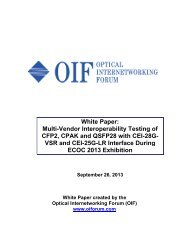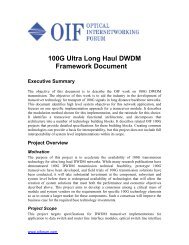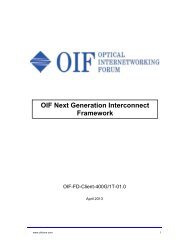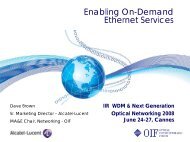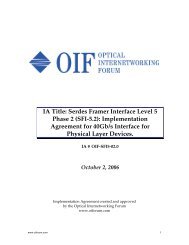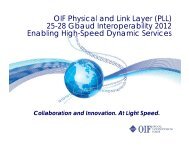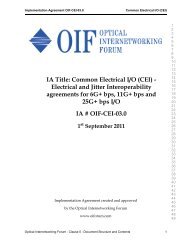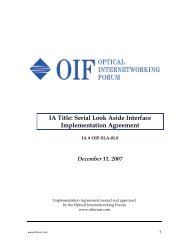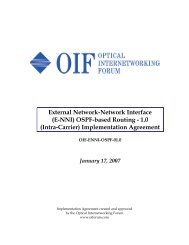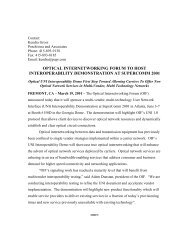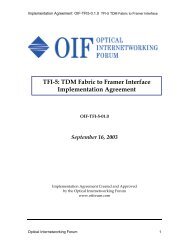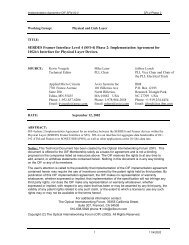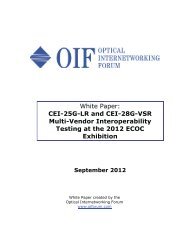White Paper CEI-25G-LR and CEI-28G-VSR Multi-Vendor ...
White Paper CEI-25G-LR and CEI-28G-VSR Multi-Vendor ...
White Paper CEI-25G-LR and CEI-28G-VSR Multi-Vendor ...
Create successful ePaper yourself
Turn your PDF publications into a flip-book with our unique Google optimized e-Paper software.
<strong>White</strong> <strong>Paper</strong><strong>CEI</strong>-<strong>25G</strong>-<strong>LR</strong> <strong>and</strong> <strong>CEI</strong>-<strong>28G</strong>-<strong>VSR</strong><strong>Multi</strong>-<strong>Vendor</strong> InteroperabilityTestingMarch 2012<strong>White</strong> <strong>Paper</strong> created by theOptical Internetworking Forumwww.oiforum.com
ContributorsEditor & PLL Interoperability Chair: Ed FrlanAltera: Salman Jiva, Mike LiAmphenol: Greg McSorleyFujitsu Optical Components: Nobuyoshi Horigome, Hideki IsonoGennum: Ed Frlan, Dave BrownIBM: Mounir Meghelli, David StaufferInphi: Richard WardLuxtera: Tom PalkertMolex: Scott Sommers, Mehrdad SaberiTE Connectivity: Nathan TracyXilinx: Martin Gilpatricwww.oiforum.com 2
Executive SummaryThe Optical Interworking Forum has been developing a set of Clauses focused onspecifying a set of new electrical interfaces applicable to higher speed opticalsystems requiring interconnect baud rates of 19.90 Gbaud to 28.05 Gbaud usingNRZ coding. The OIF membership, consisting of semiconductor, connector, opticsuppliers, communications equipment OEMs, <strong>and</strong> service providers, allows a uniqueperspective of developing industry requirements, <strong>and</strong> a comprehensiveunderst<strong>and</strong>ing of the technology trade offs necessary to enable the developmentsnecessary to support these requirements.A multi-vendor interoperability event to demonstrate the <strong>CEI</strong>-<strong>25G</strong>-<strong>LR</strong> <strong>and</strong> <strong>CEI</strong>-<strong>28G</strong>-<strong>VSR</strong> interfaces in action has been successfully carried out at the 2012 OFC/NFOEC byseveral members of the OIF Physical Link Layer (PLL) Working Group. The PLLinteroperability consisted of five individual demonstrations with ten participatingvendors. Three demonstrations addressed the 19.60-28.05 Gbaud chip-to-module<strong>CEI</strong>-<strong>28G</strong>-<strong>VSR</strong> interface <strong>and</strong> two demonstrations addressed the 19.90-25.80 Gbaud<strong>CEI</strong>-<strong>25G</strong>-<strong>LR</strong> interface for backplane applications. Interoperability participantsincluded IC, connector, optical component, optical module <strong>and</strong> test equipmentmanufacturers.www.oiforum.com 3
<strong>CEI</strong>-<strong>25G</strong>-<strong>LR</strong> <strong>and</strong> <strong>CEI</strong>-<strong>25G</strong>-<strong>VSR</strong> BackgroundInformation <strong>and</strong> ApplicationsAs the dem<strong>and</strong>s on industry data rates have increased along with the dem<strong>and</strong>s forhigher levels of traffic aggregation, the communications <strong>and</strong> networking industrieshave need of interoperable interfaces that support these next generation data rates.The OIF has been at the forefront of this dem<strong>and</strong> by leading the industry with thedevelopment of common electrical interface (<strong>CEI</strong>) implementation agreements (IA)that support 25 Gb/s over backplane architectures, 28 Gb/s in chip-to-chipapplications <strong>and</strong> 28 Gb/s in chip-to-module applications. This development work isimportant in enabling the industry to re-use conventional chassis, linecard <strong>and</strong>cabling architectures as they develop equipment that is able to meet the evolving<strong>and</strong> challenging b<strong>and</strong>width dem<strong>and</strong>s of the communications industry.<strong>CEI</strong>-<strong>25G</strong>-<strong>LR</strong> <strong>and</strong> <strong>CEI</strong>-<strong>28G</strong>-<strong>VSR</strong> are two recent OIF Clauses which address the needsof 25 Gb/s Long Reach backplane applications <strong>and</strong> 28 Gb/s Very Short Reach chipto-moduleapplications respectively. The <strong>CEI</strong>-<strong>25G</strong>-<strong>LR</strong> Clause was recently ratifiedalong with <strong>CEI</strong>-<strong>28G</strong>-SR as part of the Common Electrical I/O (<strong>CEI</strong>) 3.0Implementation Agreement. The <strong>CEI</strong>-<strong>28G</strong>-<strong>VSR</strong> Clause is under development <strong>and</strong> isexpected to be ratified later this year.Fig. 1: <strong>CEI</strong>-<strong>25G</strong>-<strong>LR</strong> Reference ModelAs shown in figure 1, backplane architectures are commonly used in commuicationsequipment. Developing 25 Gb/s backplane channel specifications is important toenable the industry to continue use of this architecture in switches, routers,transport <strong>and</strong> data center equipment. The <strong>25G</strong>-<strong>LR</strong> channel consists of 100Ωdifferential PCB traces, vias <strong>and</strong> up to two connectors. As this IA is targeted towww.oiforum.com 4
longer reach backplane applications total allowable channel loss can be up to 25 dBat Nyquist rate <strong>and</strong> the transmitter is able to generate a maximum swing of 1200mVppd <strong>and</strong> is required to have an FIR equalizer. The receiver implementation is notm<strong>and</strong>ated <strong>and</strong> can be vendor specific.Fig. 2: <strong>CEI</strong>-<strong>28G</strong>-<strong>VSR</strong> Reference ModelThe use of pluggable optical transceivers is a common practice in equipmentdeveloped for the communications market. Developing interoperable pluggable IO(input/output) solutions that keeps up with the dem<strong>and</strong>ing b<strong>and</strong>width needs ofindustry is critical to enabling next generation equipment that supports thecommunications service providers. The <strong>28G</strong>-<strong>VSR</strong> channel shown in figure 2 consistsof 100Ω differential PCB traces, vias, one connector <strong>and</strong> AC coupling capacitors. The<strong>28G</strong>-<strong>VSR</strong> IA is intended to be used for Very Short Reach channels with up to 10 dBloss at Nyquist rate <strong>and</strong> is being initially targeted for the next generation of opticalmodules having retimed interfaces operating at 25 – 28 Gb/s.OIF PLL <strong>Multi</strong>-<strong>Vendor</strong> Interoperability TestingObjectivesInteroperability is one of the keys to the success of any st<strong>and</strong>ard. In order topromote the acceptance <strong>and</strong> demonstrate the viability of <strong>CEI</strong>, the OIF sponsored aprivate, closed door interoperability Plugfest in January of 2012. Proving that <strong>CEI</strong> iswidely supported by various companies across the industry the participants includedfive semiconductor manufacturers (Altera, Gennum, IBM, Inphi <strong>and</strong> Xilinx), threeconnector vendors (Amphenol, Molex <strong>and</strong> TE Connectivity), two optical modulevendors (Fujitsu Optical Components <strong>and</strong> Molex), one optical component vendor(Luxtera) <strong>and</strong> one test equipment manufacturer (Tektronix). Cooperation betweensemiconductor, connector, optical module, optical component <strong>and</strong> test equipmentsuppliers is crucial to enable implementation <strong>and</strong> integration of high-speed signalingby system vendors. OFC 2012 will showcase working demonstrations of the the<strong>25G</strong>-<strong>LR</strong> <strong>and</strong> <strong>28G</strong>-<strong>VSR</strong> Clauses, using test scenarios similar to the privateinteroperability tests.www.oiforum.com 5
OIF Interop Test EquipmentTest equipment supplied to the PLL Interop by Tektronix included the following:DSA8300 Series Sampling Scope: The Tektronix DSA8300 is a modular oscilloscopeplatform that provides a low native instrument jitter floor (425 fs RMS) for accurateacquisition of up to 8 test channels.Analysis of eye diagrams <strong>and</strong> jitter using 80SJARB jitter measurement applicationsoftware address IEEE 802.3ba requirements for J2 <strong>and</strong> J9 jitter measurements.Equipped with the 80C10B Optical Module; the DSA8300 provides support forConformance Testing of 25.781 Gb/s (100GBASE-ER4 <strong>and</strong> 100GBASE-<strong>LR</strong>4), 27.739Gb/s (100GBASE-ER4 FEC <strong>and</strong> 100GBASE-<strong>LR</strong>4 FEC) st<strong>and</strong>ards in a single module.AWG7000: The Tektronix AWG7000 Series Arbitrary Waveform Generators provideup to 24 GSamples/sec <strong>and</strong> 10 Bit vertical resolution for signal stimulus of highspeed patterns <strong>and</strong> clock reference sources.www.oiforum.com 6
Demonstration No. 1Altera-Gennum-Molex <strong>CEI</strong>-<strong>28G</strong>-<strong>VSR</strong> ApplicationComponent OverviewAltera’s Stratix V FPGAs deliver the highest system b<strong>and</strong>width at the lowest powerconsumption, under 200mW per transceiver at 28 Gbps. Stratix V FPGAs supportbackplane, chip-to-optical module, <strong>and</strong> chip-to-chip applications through 28 Gbpstransceivers, <strong>and</strong> up to 66 full-duplex 14.1 Gbps transceivers. The transceivers inStratix V FPGAs provide the industry's highest system reliability <strong>and</strong> performancewith the lowest jitter.The zQSFP+ system from Molex supports next-generation 100 Gbps Ethernet <strong>and</strong>100 Gbps InfiniB<strong>and</strong>* Enhanced Data Rate (EDR) applications with excellent thermalcooling, signal integrity (SI), electro magnetic interference (EMI) protection <strong>and</strong> thelowest power consumption in the industry.Leveraging a generation of innovation in 10G module CDRs, Gennum's GN2425 <strong>and</strong>GN2426 are low-power retimers optimized for reference-free 25-<strong>28G</strong>bps operation innext-generation optical modules <strong>and</strong> active cables. By resetting the jitter budgetswithin the module in both directions, Gennum’s CDRs are perfect for challenging newapplications such as 100GBASE-<strong>LR</strong>4/ER4 <strong>and</strong> OTU4 CFP2 optical modules. TheGN2425 <strong>and</strong> GN2426 feature best-in-class receive sensitivity, input jitter tolerance<strong>and</strong> output jitter, allowing for reliable signal recovery <strong>and</strong> clean, wide-open transmiteyes.The Molex optical module is a demonstration platform for <strong>25G</strong>bps silicon photonicstransceiver technology. The optoelectronic transceiver consists of four <strong>28G</strong>transmitters <strong>and</strong> four <strong>28G</strong> receivers integrated onto a single silicon photonics chip. ADFB laser is shared across the four externally modulated transmitter channelsenabling an aggregate un-encoded data rate of up to 112Gbps (4x28).Molex will design <strong>and</strong> bring to market products based on this technology. Theseproducts will address a variety of different st<strong>and</strong>ards, including 100Gbps Ethernet<strong>and</strong> InfiniB<strong>and</strong> EDR optical interconnect applications, <strong>and</strong> will be compliant with theemerging OIF Short Reach (SR) <strong>and</strong> Very Short Reach (<strong>VSR</strong>) electrical module/hostinterconnect specifications.Demo 1 descriptionThis demonstration system consists of the following blocks: an Altera Stratix V GTFPGA, a Gennum 12-dB <strong>VSR</strong> host channel, a Molex zQSFP+ connector, GennumClock-<strong>and</strong>-Data Recovery ICs, <strong>and</strong> a Molex 1490nm 4x<strong>28G</strong> Optical TransceiverModule. The system generates PRBS31 data at 28.05 Gb/s rate within the FPGAwhich is transmitted over a Gennum <strong>VSR</strong> host channel having 12 dB of insertion lossthrough a Molex zQSFP+ connector to the Gennum CDR ICs. The retimed outputs ofthe CDRs are transmitted to the Molex Optical Module which loops the optical databack to its receiver through 2 km of SM fiber. In the receive direction the data flowis in the reverse order through the cascaded blocks terminating at the PRBS31 errorcheckers within the Altera FPGA in order to verify that the entire transmit <strong>and</strong>receive data path through the system is operating error free. An electrical data eyewww.oiforum.com 7
is shown on a Tektronix DSA8300 Digital Sampling Oscilloscope at one of theGennum CDR outputs.Rx<strong>VSR</strong> channel BoardGennum RetimerBoardAlteraFPGAwith<strong>28G</strong> <strong>VSR</strong>SERDESRetimerICsMolexOpticalmoduleTxMolex zQSFP+ConnectorFig. 3: Demo No. 1 Block Diagramwww.oiforum.com 8
Demonstration No. 2Xilinx-TE Connectivity-Fujitsu <strong>CEI</strong>-<strong>28G</strong>-<strong>VSR</strong>ApplicationComponent OverviewXilinx utilized their Virtex-7 GTZ test chip (built with ceramic package) for the Virtex-7HT FPGA, in the interoperability testing with 4 channels running a PRBS-31 patternat 25.78Gbps. The serial I/Os have both programmable transmit pre/post-emphasis<strong>and</strong> active linear receive equalization optimized for <strong>VSR</strong> channels. A 2-D eye scan isalso available at the receiver for link tuning.TE Connectivity’s zQSFP+ connector is a new high speed, high density interconnectthat supports data rates from 28 Gbps per lane over the connector’s 4 channels,providing an aggregate b<strong>and</strong>width of 100Gbps. The connector interface is fullybackwards compatible to the existing QSFP+ modules <strong>and</strong> cable assemblies.Through a coupled, narrow-edged, blanked- <strong>and</strong> formed- contact geometry <strong>and</strong>insert molding design, the zQSFP+ interconnect exhibits superior signal integrity,mechanical <strong>and</strong> electrical performance. For this demo with Fujitsu’s CFP2transceiver, the connector would normally be a CFP2 connector, but in this case twozQSFP+ connectors have been substituted.Fujitsu Optical Component's (FOC) CFP2 style transceiver is designed to comply withthe OIF <strong>28G</strong>-<strong>VSR</strong> specification, which is the next generation electrical interface tosupport 100G technology. The introduction of this new interface, together with thehigh density integration technology of optical <strong>and</strong> electrical parts, enables thecompact sized (about half width of the current CFP) <strong>and</strong> low power consumption(about 1/3 of the current CFP) transceivers. The target form factor of this transceiveris "CFP2" (http://www.cfp-msa.org/) which is now under creation by CFP-MSAgroup.Demo 2 descriptionThe Xilinx Virtex-7 GTZ test chip generates four channels running a PRBS31 patternat 25.78Gbps. These channels drive a Fujitsu 13 dB insertion loss channel to TE’s<strong>28G</strong>bps zQSFP+ connector. The signal then feeds to Fujitsu’s CFP2-style opticaltransceiver which includes an integrated CDR. The signal optically loops throughsingle mode fiber back through the transceiver, through the connector to the chipreceiver section ending at the PRBS31 error checkers within the Xilinx chip.www.oiforum.com 9
Rx<strong>VSR</strong> channel BoardXilinxchip with<strong>25G</strong> <strong>VSR</strong>SERDESFujitsu CFP2 StyleOptical moduleTx2x TE ConnectivityzQSFP+ ConnectorsFig. 4: Demo No. 2 Block Diagramwww.oiforum.com 10
Demonstration No. 3IBM-Amphenol-Inphi-Luxtera <strong>CEI</strong>-<strong>28G</strong>-<strong>VSR</strong>ApplicationComponent OverviewIBM's High Speed Serial (HSS) <strong>28G</strong> core is available as part of the IBM Cu32 CustomLogic product offering. It provides state-of-the-art jitter performance <strong>and</strong> adaptiveequalization for high density serial communications across high-loss channels, suchas backplane <strong>and</strong> copper cable links.Amphenol’s Expressport TM QSFP E Series Connectors (FS1-E38-X0M0-X0) aredesigned for 25-<strong>28G</strong> applications <strong>and</strong> are backward compatible with current QSFPconnector footprints <strong>and</strong> cage assemblies. The E series connectors also feature aunique ground commoning device which reduces crosstalk at resonant frequencies<strong>and</strong> lowers common-mode reflections.Inphi’s CMOS 100G Ethernet <strong>and</strong> OTU4 Quad 25-<strong>28G</strong> Retimer targets nextgenerationultra low power optical modules with new levels of integration <strong>and</strong>advanced metrics <strong>and</strong> analysis on-die. Containing transmit <strong>and</strong> adaptive receiveequalization, this device is designed to exceed <strong>28G</strong>-<strong>VSR</strong> requirements for opticalmodule attachment with lowest power in the industry.Leveraging the benefits of Silicon Photonics, Luxtera’s single chip opto-electronictransceiver includes four fully integrated <strong>28G</strong>bps transmit <strong>and</strong> receive channelspowered from a single laser for an aggregate unencoded data rate of up to 112Gbps.The device is targeted for 100Gbps Ethernet, OTN <strong>and</strong> InfiniB<strong>and</strong> applications as wellas emerging OIF (Optical Internetworking Forum) Short Reach (SR) <strong>and</strong> Very ShortReach (<strong>VSR</strong>) electrical interconnect to host systems.Demo 3 descriptionDemo 3 demonstrates an electrical to optical 100G OUT4 rate system (4 x <strong>28G</strong>) forline card <strong>and</strong> pluggable optical module applications.The IBM device generates 4 x <strong>28G</strong> lanes with a PRBS31 which pass through theAmphenol QSFP E Series connector HCB/MCB system to the Inphi Retimer. TheInphi device verifies the pattern <strong>and</strong> calculates BER as the stream passes includingnon-destructive high resolution eyes. The Retimer feeds the Luxtera optical modulefor 1490nm optical transport. With optical loopback, the Luxtera receives the stream<strong>and</strong> sends back to the 2 nd Inphi Retimer, which passes the data back through theAmphenol connector, returning to the IBM ASIC for pattern verification <strong>and</strong> marginanalysis.www.oiforum.com 11
Amphenol QSFP+MCB/HCBIBM<strong>28G</strong>ASICTxRxTXCDRRXCDRLuxteraOpticalModule14dB channelInphi RetimerBoardFig. 5: Demo No. 3 Block Diagramwww.oiforum.com 12
Demonstration No. 4IBM-Molex <strong>CEI</strong>-<strong>25G</strong>-<strong>LR</strong> ApplicationSilicon OverviewIBM's High Speed Serial (HSS) <strong>28G</strong> core is available as part of the IBM Cu32 CustomLogic product offering. It provides state-of-the-art jitter performance <strong>and</strong> adaptiveequalization for high density serial communications across high-loss channels, suchas backplane <strong>and</strong> copper cable links.Connector OverviewMolex's Impact backplane connector is designed to support data rates perdifferential pair of 25+Gbps with superior signal density up to 80 differential pairsper inch. Impact’s broad edge coupled geometry provides low cross-talk, lowinsertion loss <strong>and</strong> minimal insertion loss deviation across all high-speed channels.The PCB footprint of the Impact connector system is available in two compliant-pindesign options on both daughter card <strong>and</strong> backplane connectors to allow systemdesigners maximum flexibility in balancing signal integrity performance withmechanical stability <strong>and</strong> PCB manufacturing process limitations. The matinginterface provides in-line staggered, bifurcated contacts that provide two points ofcontact for long-term reliability performance, low mating forces, <strong>and</strong> minimalelectrical interface stub for optimal high speed performance.Backplane OverviewThe Molex Impact Reference Backplane system consists of two daughter cards, abackplane, <strong>and</strong> two Impact mated connectors. The Impact connector is made upof a vertical header on the backplane PCB <strong>and</strong> a right-angle receptacle on thedaughter card PCB. The Impact daughter cards are 110mils thick, 12 layers each,<strong>and</strong> use Megtron 6 material with VLP foil surface finish. 1 The daughter card tracelengths are 5” from test point to connector <strong>and</strong> utilize a 5/5/5 trace width <strong>and</strong>spacing combination. The Impact backplane cards are 249mils thick, 26 layers, <strong>and</strong>use Megtron 6 material with HVLP foil surface finish. The backplane utilizes either6/6/6 or 7/10/7 trace width <strong>and</strong> spacing combinations with channels providing thedesired test range of -25db to -35db of loss across a combination of lengths.Demo 4 descriptionThe goal of this Interop is to demonstrate a 4-lane 100G operation across abackplane link with end-to-end loss in excess of 30dB at 12.9GHz. Each lane willcarry a PRBS-31 running at 25.781<strong>25G</strong>b/s data rate. PRBS generation <strong>and</strong> checkingis performed on-chip. Error rate <strong>and</strong> link margins are reported using on-chipdiagnostics.Demo 4 will show an IBM <strong>28G</strong> test chip operating over a Molex-supplied referencebackplane built with Megtron 6 material <strong>and</strong> featuring their Impact BackplaneConnector product.1 Megtron is a registered trademark of Panasonicwww.oiforum.com 13
4x <strong>25G</strong>b/s Long Reach Backplane LinksDaughter CardIBM<strong>28G</strong>ASICDaughter CardMolex ImpactConnectorMolex ImpactConnectorFig. 6: Demo No. 4 Block DiagramBackplanewww.oiforum.com 14
Demonstration No. 5IBM-TE Connectivity - <strong>CEI</strong>-<strong>25G</strong>-<strong>LR</strong> ApplicationSilicon OverviewIBM's High Speed Serial (HSS) <strong>28G</strong> core is available as part of the IBM Cu32 CustomLogic product offering. It provides state-of-the-art jitter performance <strong>and</strong> adaptiveequalization for high density serial communications across high-loss channels, suchas backplane <strong>and</strong> copper cable links.Connector OverviewTE’s STRADA Whisper backplane connector is designed to support data rates perdifferential pair up to 40Gbps. The connector’s individually shielded pairs results innoise performance that is less than 1% @ 20 ps signal edge rates <strong>and</strong> insertion lossof less than 1db <strong>and</strong> flat past 15GHz. The in-row “horizontal” pair orientation resultsin zero skew. Since PCB interfaces are a critical element of over-all connectorperformance, the STRADA Whisper connector footprint has been optimized to providea balanced solution to the competing requirements of impedance, cross talk <strong>and</strong>routability.Backplane OverviewThe TE supplied reference backplane channel consists of two daughter cards, abackplane, <strong>and</strong> two STRADA Whisper connectors. The STRADA Whisper connector ismade up of a vertical header <strong>and</strong> a right-angle receptacle. The IBM <strong>28G</strong> ASICconnects to the TE daughter cards through SMA connectors.The daughter cards are 110mils thick using Megtron 6 material encompassing 14layers each. 2 All of the differential traces routed from the SMA test points to theskew-less STRADA Whisper connector footprint are 5” in length in a 6-9-6 mil tracewidth configuration. The traces <strong>and</strong> other copper in the boards utilize Megtron 6 VLPfoil finishes. The signal vias in both the STRADA Whisper connector <strong>and</strong> SMA testpoints are counter-bored to within 10 mils of the signal layer. The daughter cardcontains the STRADA Whisper receptacle.The backplane, which contains the STRADA Whisper header, is 200mils thick usingMegtron 6 material encompassing 20 layers. All of the differential traces routed onthe backplane are in a 7-9-7 mil trace width configuration. The traces <strong>and</strong> othercopper in the board utilize a Megtron 6 H-VLP foil finish. The signal vias in theSTRADA Whisper connector footprint are counter-bored to within 10mils of the signallayer. The backplane demonstrates lengths of 4, 8, 17, <strong>and</strong> 30”. When combinedwith a daughter card on each end the total trace length demonstrated in the channelis extended to 14, 18, 17, <strong>and</strong> 40”.2 Megtron is a registered trademark of Panasonic.www.oiforum.com 15
Demo 5 descriptionThe goal of the demonstration is to exhibit the OIF <strong>CEI</strong> <strong>25G</strong> <strong>LR</strong> ImplementationAgreement (IA) with 4-lane 100G operation across a backplane link with end-to-endloss in excess of 30dB at 12.9GHz. Each lane carries a PRBS-31 pattern running at a25.781<strong>25G</strong>b/s data rate. PRBS generation <strong>and</strong> checking is performed on-chip.The demonstration contains an IBM 32nm <strong>28G</strong> test chip operating over a TEConnectivity-supplied reference backplane. It is also built with Megtron6 material<strong>and</strong> implements TE’s STRADA Whisper backplane connector product.The 40” channel, which is used in this demonstration, contains approximately 30 dBof loss from the SMA on one daughter card to the SMA on the other daughter card.The demonstration runs 4 lanes at <strong>25G</strong>bps with 2 additional lanes used in order toincrease the amount of XT aggressors.4x <strong>25G</strong>b/s Long Reach Backplane LinksDaughter CardIBM<strong>28G</strong>ASICDaughter CardTE STRADA WhisperConnectorTE STRADA WhisperConnectorBackplaneFig. 7: Demo No. 5 Block Diagramwww.oiforum.com 16
ConclusionsThis interoperability demonstration successfully brought semiconductor, connector, opticalmodule <strong>and</strong> test equipment vendors together to show that the <strong>CEI</strong>-<strong>25G</strong>-<strong>LR</strong> <strong>and</strong> <strong>CEI</strong>-<strong>28G</strong>-<strong>VSR</strong>Clauses have evolved from concept to reality <strong>and</strong> that a viable ecosystem is now in place toenable the commercial success of the next generation of optical module electrical interfaces inthe 25 – 28 Gbaud speed range along with the backplane architectures operating with 25 Gbaudchannels.www.oiforum.com 17



